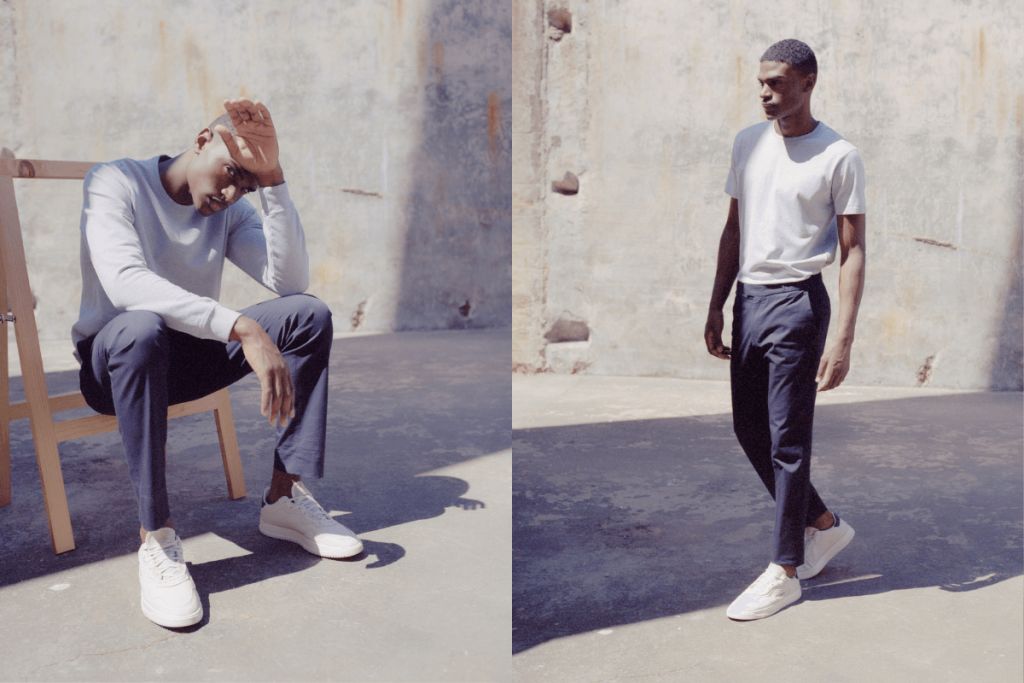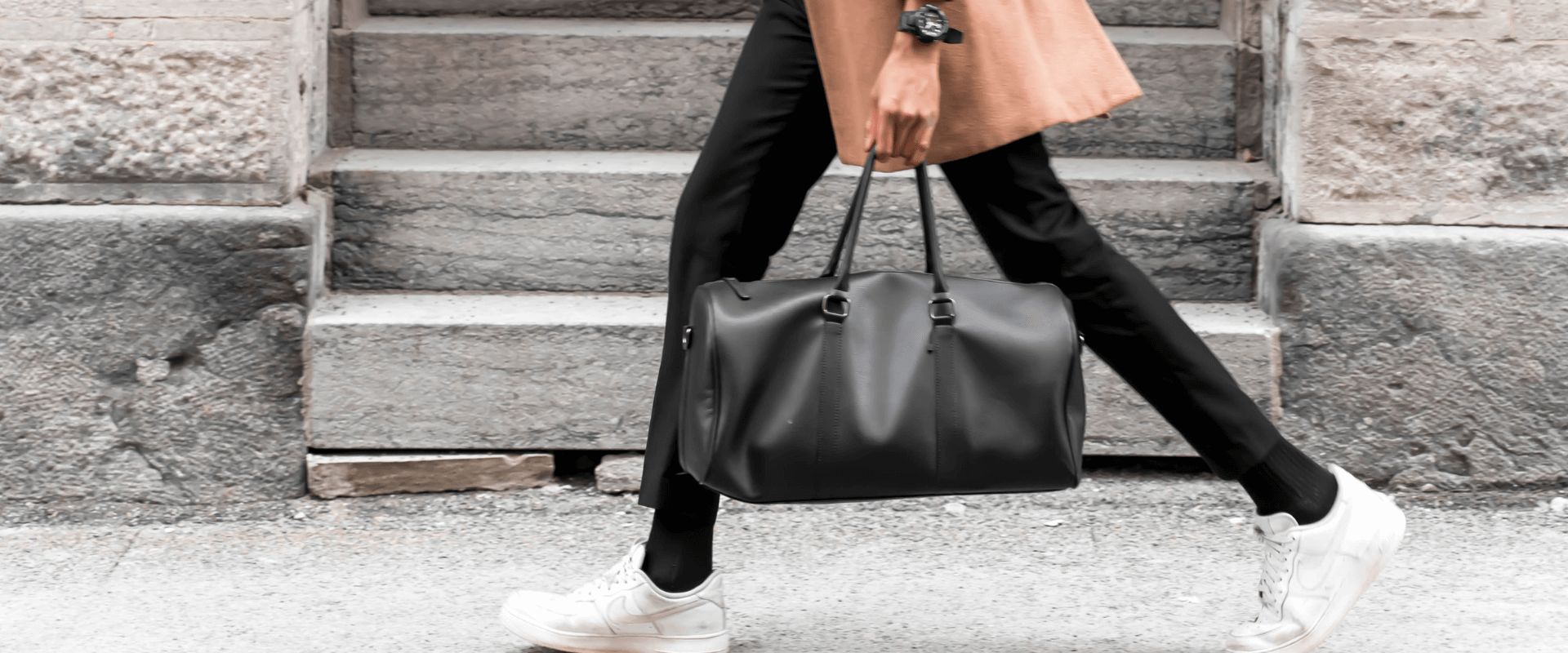It’s no big secret that we at SANVT are true chino pants stans. After all, no other trousers are such an all-rounder as chinos. They can be styled for business as well as for leisure and do not impose themselves on any outfit. They are multifunctional, sophisticated, sporty and elegant. But what exactly distinguishes chinos from classic suit pants? At SANVT, we show you the essential differences between chinos and formal trousers.
While many modern men can now find their way between cargo pants, cloth trousers, khakis, suit trousers, chinos, sweatpants, jeans and many other types of legwear, such a wide array of options can lead to serious headaches. Knowing the difference between two types of trousers can alleviate that kind of pain. And there’s actually a lot of confusion around the difference between chinos vs. formal trousers.
So let us give you a leg up, and level up your knowledge about chinos vs. formal trousers. After reading this, you will be a true smarty pants!
Chinos vs. formal trousers: an overview of the main differences
- Style: chinos are business casual, trousers are more formal
- Material: chinos are made of stretch cotton, formal trousers are made of new wool
- Fit: Chinos usually come in a slim fit, formal trousers are usually straight cut
- Length: Chinos can be worn shorter, formal trousers should finish with the top edge of the shoe

Chris Fraas styles the Smart Chino casually with a white tee & Habib Akinmade with chunky oxford shoes and a shirt.
The characteristics of chinos
High-quality chinos – like the Smart Chinos from SANVT – are typically made from a multi-functional stretch cotton and offer innovative design features such as discreet side pockets, flexible fastening systems and hidden mobile phone pockets. The lightweight twill fabric makes chinos breathable, temperature-regulating, durable and extremely comfortable. To top it all off, chinos are known for their maximum freedom of movement! The conventional cut of chinos is the slim fit, which contours every body type and ensures a smart yet casual appearance. And if you’re looking to find the ideal fit for your next chinos, you can learn that here.
Chinos also come in a variety of timeless colours, such as beige, black, grey and navy. When it comes to its design, we always lean heavily towards a minimalist aesthetic that can be dressed up or down in an elegant or sporty way. In short, chinos are the ideal bridge between classic formal trousers and informal cloth pants or jeans. Hardly any other piece of men’s fashion can be interpreted in such a versatile way as the chino. And to make sure you don’t flop with your chino, you can read here when to wear chinos and when not to.

Chinos are known to be business casual. The Smart Chino by SANVT comes in a timeless design and luxurious quality
The characteristics of formal trousers
Suit trousers are definitely a more classic and sophisticated, but sometimes also more old-fashioned alternative to chinos. Of course, it all depends on the model, the cut, the occasion and the fabric. They say: the finer the occasion, the finer the fabric. Besides new wool, flannel, cashmere-wool blends and mohair, corduroy and tweed fabrics are also suitable for more casual occasions. A high-quality pair of trousers is a sign of true craftsmanship and can be recognised not only by the fineness of its fabric, but also by the elaborately finished seams, the fine lining and the discreet pleat.
As far as the cut of suit trousers is concerned, they come in all sorts of variations. But basically, the cuts of men’s trousers can be divided into two categories: the Italian cut and the English cut. The most important distinguishing feature of these two types of trousers is the waistband height, which sits on the hip in the Italian cut and on the waist in the English cut. The waistband height of the Italian cut is thus lower and is therefore often worn with a belt, while the trousers become slightly narrower towards the bottom. The waistband of the English cut is higher and is divided at the back. The cut of the trouser legs is narrow and straight.

While straight cuts are definitely the safest choice, sportier and narrower leg ends (à-la tapered trousers) are becoming increasingly popular for suit trousers. Old school tailors, however, say that the leg cuff on formal trousers should be the shoe size minus 2cm. With this timeless cut, you achieve a very classic, straight leg end that harmonises ideally with elegant dress shoes. In addition to the leg, the length of the formal trousers is of essential importance. If the trousers are too long, they will look baggy. If they are too short, however, all the elegance is lost. The rule of thumb here is: classic suit trousers should end with the upper edge of the shoe or the heel (for a more traditional look).
As you can see, there are many details that need to be taken into account when it comes to formal trousers! And as refined as these trousers may be, they can quickly look old-fashioned and stuffy if cut and designed incorrectly. That’s why we recommend you have your suit trousers tailor-made, because that’s the only way to get the perfect elegant pants that will last for a lifetime.
But let’s summarize the most important differences between chinos and formal pants when it comes to style, material and fit.

Style
Chinos are the prime example of business casual, while formal trousers are elegant and classy. A chino can be combined with sneakers as well as with boots and oxford shoes. Formal trousers, on the other hand, only look truly sharp when worn with lace-up shoes or loafers. And while chinos can be worn with a polo shirt, t-shirt or even sweatshirt, formal trousers are best worn with a shirt or turtleneck and a matching blazer or coat. And although formal trousers are not quite as versatile for everyday wear, they are definitely a must-have that no wardrobe should be missing. After all, you never know when you might need them!
Material
Chinos are usually made of a lightweight twill, or stretch cotton, to ensure breathability and freedom of movement. They are far more practical than suit trousers, which are usually made of fine new wool and have a lining up to the knee to make them more comfortable to wear. Meanwhile, both chinos and suit trousers can be found in a wide range of materials. In any case, we recommend that you look for fair and sustainable materials to guarantee not only long-lasting but also sustainable pants.
Fit & length
Suit trousers are the more sophisticated and complex trousers that ideally come with a low waistband, straight cut and minimally narrower leg and a length that finishes with the top edge of the shoe or heel. Chinos, on the other hand, are recommended in a slim fit – depending on your physique with proportional length and width. That’s why you can choose the Smart Chino from SANVT according to length and width to get a product that is almost tailor-made. You can also wear your chino shorter or rolled up with sneakers (a look we personally love). Our chino is therefore not only a masterpiece of modern tailoring but also the quintessence of contemporary design!
Chino vs. formal trousers: the bottom line
Now that we’ve explained the main differences between both iconic styles, all doubts should be cleared up once and for all. One thing is certain: from now on, you’re going to be the one wearing the pants in any conversation about chinos vs. formal trousers!
Photos by Chris Fraas & Habib Akinmade

